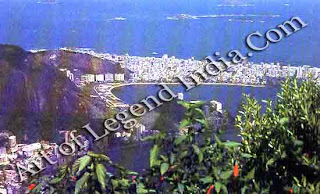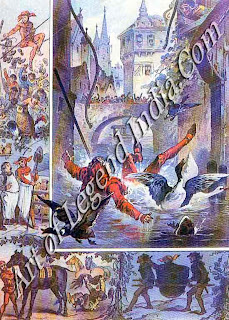A Year in the Life 1500
In this
jubilee year, pilgrims made their way to Rome in search of spiritual
redemption, which was being dispensed by the greedy Borgia Pope, Alexander VI.
And while Bosch was exploring the wilder shores of the human psyche, Spain and
Portugal were sending emissaries on uncharted waters in search of spices.
While
Bosch reflected medieval preoccupations with his visions of hell and sense of
sin, the cynical Pope Alexander VI was eager to capitalize on them. He declared
1500 a jubilee year a year when penitents could shed their sins and be granted
complete absolution and welcomed thousands of pilgrims from all over Europe to
the Eternal City. He hoarded their alms in a special fund administered by his
son, Cesare Borgia, for the 'pacification' of those rebellious cities which
refused to pay dues to the papacy. For this service, Cesare was made Vicar of
Rome in March 1500.
In his
concern to preserve and enlarge papal dominions, Alexander issued an edict
proclaiming a crusade against the infidel Turks who were steadily advancing in Eastern
Europe. Alexander appealed for support directly to the King of France, but
Louis XII was much more interested in recovering the duchy of Milan from
Leonardo da Vinci's sometime patron, Ludovico Sforza. Early in 1500, French troops
took the city; Ludovico himself was captured, and spent the rest of his life in
a French dungeon.
THE DISCOVERY OF AMERICA
 Dramatic
events were taking place outside Europe. In 1492, Christopher Columbus had
crossed the Atlantic hoping to reach the fabled East, instead of which he had
discovered America. In 1500 he still believed (as he was always to believe)
that his voyages had taken him to the edge of 'the Indies', although in the
same year his pilot, Juan de la Cosa, drew the earliest surviving map of the
world, showing for the first time the eastern seaboard of North and South
America in rough outline, with special prominence given to Spanish possessions,
optimistically marked with a flag.
Dramatic
events were taking place outside Europe. In 1492, Christopher Columbus had
crossed the Atlantic hoping to reach the fabled East, instead of which he had
discovered America. In 1500 he still believed (as he was always to believe)
that his voyages had taken him to the edge of 'the Indies', although in the
same year his pilot, Juan de la Cosa, drew the earliest surviving map of the
world, showing for the first time the eastern seaboard of North and South
America in rough outline, with special prominence given to Spanish possessions,
optimistically marked with a flag.
The
year proved a particularly bad one for Columbus himself. Although a great
sailor, he was an inept administrator, and as governor of the Spanish colony of
Hispaniola (modern Haiti) he combined an often heavy hand with an inability to
maintain order among the unruly settlers. Ferdinand and Isabella of Spain were
advised of his incompetence, and appointed a new governor who promptly shipped
the great discoverer back to Spain in chains.
The
Spaniards had high hopes of their transatlantic discoveries, and the Portuguese
took them seriously enough to insist0 on a share for themselves. A formally
agreed line of demarcation, approved by Pope Alexander, had divided all 'new'
lands between Spain and Portugal although, as the future was to show, the
English, Dutch and French had no intention of observing this lordly private
arrangement.

But in
1500 the Atlantic crossing was old news. For it was rumoured that the
Portuguese captain Vasco da Gama had discovered a new route to India - and
wealth from the spice trade. The Portuguese immediately set out to exploit their
advantage. In March 1500 a fleet loaded with trading goods set out from Lisbon
under the command of Pedro Alvarez Cabral. Following the example of da Gama,
Cabral swung his ships into the mid Atlantic in order to avoid bad weather and
dangerous currents off the African coast; the intention was to reach the
steadily blowing South Atlantic westerlies and run before them to the Cape.

In the
event, Cabral swung too far west, and made land fall on an unknown shore: by
accident he had found Brazil, which was to become the largest of all Portugal's
colonies. He left two men there as observers, and sent a ship back to Portugal
with news of the discovery. Then he pressed on across the Atlantic as it was
still the spices that mattered most. Four of Cabral's ships were lost off the
Cape of Good Hope, but contemporary profit margins were high enough to ride
such losses. Cabral did splendid business in the East and returned to Lisbon in
July 1501, his ships crammed with spices, incense, porcelain and other exotic products.
Portugal's golden age of wealth and empire had begun.
Writer
– Marshall Cavendish
 Dramatic
events were taking place outside Europe. In 1492, Christopher Columbus had
crossed the Atlantic hoping to reach the fabled East, instead of which he had
discovered America. In 1500 he still believed (as he was always to believe)
that his voyages had taken him to the edge of 'the Indies', although in the
same year his pilot, Juan de la Cosa, drew the earliest surviving map of the
world, showing for the first time the eastern seaboard of North and South
America in rough outline, with special prominence given to Spanish possessions,
optimistically marked with a flag.
Dramatic
events were taking place outside Europe. In 1492, Christopher Columbus had
crossed the Atlantic hoping to reach the fabled East, instead of which he had
discovered America. In 1500 he still believed (as he was always to believe)
that his voyages had taken him to the edge of 'the Indies', although in the
same year his pilot, Juan de la Cosa, drew the earliest surviving map of the
world, showing for the first time the eastern seaboard of North and South
America in rough outline, with special prominence given to Spanish possessions,
optimistically marked with a flag. 













0 Response to "Netherlandish Great Artist Hieronymus Bosch -A Year in the Life 1500"
Post a Comment